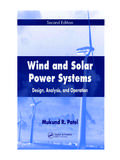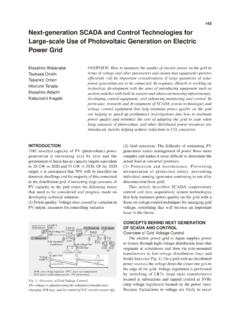Transcription of Micropower System Modeling with HOMER - …
1 CHAPTER 15 Micropower System MODELINGWITH HOMERTOM LAMBERTM istaya Engineering GILMAN and PETER LILIENTHALN ational Renewable Energy INTRODUCTIONThe HOMER Micropower Optimization Model is a computer model developed bythe National Renewable Energy Laboratory (NREL) to assist in the design ofmicropower systems and to facilitate the comparison of power generation technol-ogies across a wide range of applications. HOMER models a power System s phy-sical behavior and its life-cycle cost, which is the total cost of installing andoperating the System over its life span. HOMER allows the modeler to comparemany different design options based on their technical and economic merits. Italso assists in understanding and quantifying the effects of uncertainty or changesin the systemis a System that generates electricity, and possibly heat, toserve a nearby load. Such a System may employ any combination of electricalgeneration and storage technologies and may be grid-connected or autonomous,meaning separate from any transmission grid.
2 Some examples of Micropower sys-tems are a solar battery System serving a remote load, a wind diesel System servingan isolated village, and a grid-connected natural gas microturbine providing elec-tricity and heat to a factory. Power plants that supply electricity to a high-voltagetransmission System do not qualify as Micropower systems because they are notIntegration of Alternative Sources of Energy, by Felix A. Farret and M. Godoy Sim~ooesCopyright#2006 John Wiley & Sons, to a particular load. HOMER can model grid-connected and off-gridmicropower systems serving electric and thermal loads, and comprising any com-bination of photovoltaic (PV) modules, wind turbines, small hydro, biomass power,reciprocating engine generators, microturbines, fuel cells, batteries, and analysis and design of Micropower systems can be challenging, due to thelarge number of design options and the uncertainty in key parameters, such as loadsize and future fuel price.
3 Renewable power sources add further complexitybecause their power output may be intermittent, seasonal, and nondispatchable,and the availability of renewable resources may be uncertain. HOMER wasdesigned to overcome these performs three principal tasks: simulation, optimization, and sensitivityanalysis. In the simulation process, HOMER models the performance of a particularmicropower System configuration each hour of the year to determine its technicalfeasibility and life-cycle cost. In the optimization process, HOMER simulates manydifferent System configurations in search of the one that satisfies the technical con-straints at the lowest life-cycle cost. In the sensitivity analysis process, HOMER performs multiple optimizations under a range of input assumptions to gauge theeffects of uncertainty or changes in the model inputs. Optimization determinesthe optimal value of the variables over which the System designer has controlsuch as the mix of components that make up the System and the size or quantityof each.
4 Sensitivity analysis helps assess the effects of uncertainty or changes inthe variables over which the designer has no control, such as the average windspeed or the future fuel illustrates the relationship between simulation, optimization, andsensitivity analysis. The optimization oval encloses the simulation oval to representthe fact that a single optimization consists of multiple simulations. Similarly, thesensitivity analysis oval encompasses the optimization oval because a single sensi-tivity analysis consists of multiple AnalysisFigure relationship between simulation, optimization, and System Modeling with HOMERTo limit input complexity, and to permit fast enough computation to make opti-mization and sensitivity analysis practical, HOMER s simulation logic is lessdetailed than that of several other time-series simulation models for micropowersystems, such as Hybrid2 [1], PV-DesignPro [2], and PV*SOL [3].
5 On the otherhand, HOMER is more detailed than statistical models such as RETS creen [4],which do not perform time-series simulations. Of all these models, HOMER isthe mostflexible in terms of the diversity of systems it can this chapter we summarize the capabilities of HOMER and discuss the ben-efits it can provide to the Micropower System modeler. In Sections we describe the structure, purpose, and capabilities of HOMER and introducethe model. In Sections and we discuss in greater detail the technical andeconomic aspects of the simulation process. A glossary defines many of the termsused in the SIMULATIONHOMER s fundamental capability is simulating the long-term operation of a micro-power System . Its higher-level capabilities, optimization and sensitivity analysis,rely on this simulation capability. The simulation process determines how a parti-cularsystem configuration, a combination of System components of specific sizes,and an operating strategy that defines how those components work together, wouldbehave in a given setting over a long period of can simulate a wide variety of Micropower System configurations, com-prising any combination of a PV array, one or more wind turbines, a run-of-riverhydro-turbine, and up to three generators, a battery bank, an ac dc converter, anelectrolyzer, and a hydrogen storage tank.
6 The System can be grid-connectedor autonomous and can serve ac and dc electric loads and a thermal shows schematic diagrams of some examples of the types of micro-power systems that HOMER can that contain a battery bank and one or more generators require a dis-patch strategy, which is a set of rules governing how the System charges the batterybank. HOMER can model two different dispatch strategies: load-following andcycle-charging. Under the load-following strategy, renewable power sources chargethe battery but the generators do not. Under the cycle-charging strategy, wheneverthe generators operate, they produce more power than required to serve the loadwith surplus electricity going to charge the battery simulation process serves two purposes. First, it determines whether the sys-tem is feasible. HOMER considers the System to be feasible if it can adequatelyserve the electric and thermal loads and satisfy any other constraints imposed bythe user.
7 Second, it estimates the life-cycle cost of the System , which is the totalcost of installing and operating the System over its lifetime. The life-cycle cost isa convenient metric for comparing the economics of various System comparisons are the basis of HOMER s optimization process, described inSection diagrams of some Micropower System types that HOMER models: (a)adiesel System serving an ac electric load; (b)aPV battery System serving a dc electric load; (c)ahybrid hydro wind diesel System with battery backup and an ac dc converter; (d)awind dieselsystem serving electric and thermal loads with two generators, a battery bank, a boiler, and a dumpload that helps supply the thermal load by passing excess wind turbine power through a resistiveheater; (e)aPV hydrogen System in which an electrolyzer converts excess PV power intohydrogen, which a hydrogen tank stores for use in a fuel cell during times of insufficient PV power.
8 (f) a wind-powered System using both batteries and hydrogen for backup, where the hydrogen fuelsan internal combustion engine generator; (g) a grid-connected PV System ; (h) a grid-connectedcombined heat and power (CHP) System in which a microturbine produces both electricity and heat;(i) a grid-connected CHP System in which a fuel cell provides electricity and models a particular System configuration by performing an hourly timeseries simulation of its operation over one year. HOMER steps through the year onehour at a time, calculating the available renewable power, comparing it to the elec-tric load, and deciding what to do with surplus renewable power in times of excess,or how best to generate (or purchase from the grid) additional power in times ofdeficit. When it has completed one year s worth of calculations, HOMER deter-mines whether the System satisfies the constraints imposed by the user on suchquantities as the fraction of the total electrical demand served, the proportion ofpower generated by renewable sources, or the emissions of certain also computes the quantities required to calculate the System s life-cyclecost, such as the annual fuel consumption, annual generator operating hours,expected battery life, or the quantity of power purchased annually from the quantity HOMER uses to represent the life-cycle cost of the System is thetotal net present cost(NPC).
9 This single value includes all costs and revenues thatoccur within the project lifetime, with future cashflows discounted to the total net present cost includes the initial capital cost of the System components,the cost of any component replacements that occur within the project lifetime, thecost of maintenance and fuel, and the cost of purchasing power from the grid. Anyrevenue from the sale of power to the grid reduces the total NPC. In Section wedescribe in greater detail how HOMER calculates the total many types of Micropower systems, particularly those involving intermittentrenewable power sources, a one-hour time step is necessary to model the behaviorFigure (Continued)SIMULATION383of the System with acceptable accuracy. In a wind diesel battery System , for exam-ple, it is not enough to know the monthly average (or even daily average) windpower output, since the timing and the variability of that power output are as impor-tant as its average quantity.
10 To predict accurately the diesel fuel consumption, dieseloperating hours, the flow of energy through the battery, and the amount of surpluselectrical production, it is necessary to know how closely the wind power outputcorrelates to the electric load, and whether the wind power tends to come in longgusts followed by long lulls, or tends to fluctuate more rapidly. HOMER s one-hourtime step is sufficiently small to capture the most important statistical aspects of theload and the intermittent renewable resources, but not so small as to slow computa-tion to the extent that optimization and sensitivity analysis become that HOMER does not model electrical transients or other dynamic effects,which would require much smaller time shows a portion of the hourly simulation results that HOMER produced when Modeling a PV battery System similar to the one shown in Fig-ure In such a System , the battery bank absorbs energy when the PV poweroutput exceeds the load, and discharges energy when the load exceeds the PVpower output.



![[Logo To Come] - Lazard](/cache/preview/b/e/f/6/9/1/8/9/thumb-bef691898073c3588972f362b9ac0cd8.jpg)